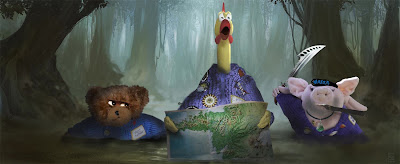Or then you can read my Launch Blog and my Inflight experience write-up.
Ok, now that you are all up-to-BTS1; So after we sent our last communication back, we landed in the swampy grass/water of the Sabine Wildlife Refuge. The landing wasn't as hard as expected but the chute dragged us a few feet. Skye Blue was going "Wheee Wheee Wheee". We did a quick crew check and we were all fine. Then it was time to check our hardware and "Inspiration" really held up well. Just at that time the last of the three cameras stopped taking images. The two video cameras had run out of battery power even before the balloon popped.
So, here we were. Somewhere inside this wildlife refuge, much further away from where the predicted landing site for the day would be. We had no idea how close or far away the rescue team was. Luckily Fuzz brought some extra astronaut food and so we just started to get comfy and hunkered down.
We were not worried about our situation, despite the fact that we didn't really know where we were, what kind of environment we were in and when we would be found. See, astronauts go through a lot of training and one important part is survival training.
Astronauts have to be prepared and ready for almost everything and any situation in space. But not only there. Each trip to space starts and ends on Earth. Spacecrafts leaving for the ISS may encounter a problem after launch and may be forced to come down in the sea, desert, tropical rain forest or a glacier; summer or winter.
But there is more to it. Our astronauts train and fly the T-38 Talon aircraft a minimum of 48 hours per year to maintain aviation and navigation proficiency. Their flights takes them over mountains, deserts and water. If they had to eject from the aircraft, the may have to fend for themselves for at least a few hours and possibly longer.
Furthermore, the training in the wilderness also provides an unique and challenging team building environment. Astronaut candidates (ASCAN) spend a lot of time together. These ASCANs bring a wide variety of experiences, ideas and philosophies together and learning teamwork and leadership skills when dealing with adverse situation out in the nature is extremely valuable.
 |
Three astronauts float down river during training at the Panama Jungle Survival School. Left to right, are Astronauts Edgar D. Mitchell, Ronald E. Evans, and Scientist-Astronaut Harrison H. Schmitt. |
 |
| ESA Astronauts being introduced to climbing techniques by a professional mountaineer during survival training, June 2010 |
For us it was time to make a fire and start singing camp fire songs. It would be a few days until we saw anyone else besides the three of us, the gators and some other very interesting animals...



What a Wonderful & Educational article. Were it Not for our inspirational figures, I would never know all these fascinating things about our "other" astronauts. We are simply Blessed to have them in our social media! 0=)
ReplyDeleteWow! Just when you thought it was tough training to be a astronaut along comes more training. You have to admire these guys!
ReplyDeletetimberlands
ReplyDeletelouis vuitton purses
jordan 3s
coach outlet
kobe shoes
louis vuitton handbags
michael kors outlet clearance
louboutin shoes
cheap oakley sunglasses
ray ban sunglasses
retro jordans 13
hollister clothing
fit flops
adidas running shoes
longchamp handbags
toms wedges
coach factory outlet
tory burch shoes
longchamp outlet
michael kors outlet
coach outlet
burberry bags
louis vuitton outlet
louis vuitton outlet
michael kors outlet clearance
ralph lauren polo shirts
nike air max 90
michael kors outlet clearance
louis vuitton outlet
oakley canada
chenyingying2016715
شركة الاتجاه الواحد
ReplyDeleteشركة الاتجاه الواحد
شركة الاتجاه الواحد
شركة الاتجاه الواحد
شركة الاتجاه الواحد
شركة الاتجاه الواحد
شركة الاتجاه الواحد
شركة الاتجاه الواحد
شركة الاتجاه الواحد
شركة الاتجاه الواحد
Thiss is a great blog
ReplyDeletejvw48ibw3
ReplyDeletegolden goose outlet
golden goose outlet
golden goose outlet
golden goose outlet
golden goose outlet
golden goose outlet
golden goose outlet
golden goose outlet
golden goose outlet
golden goose outlet